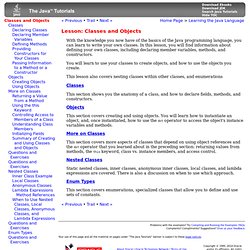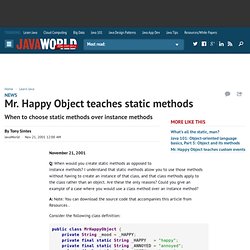

Lesson: Classes and Objects (The Java™ Tutorials > Learning the Java Language) With the knowledge you now have of the basics of the Java programming language, you can learn to write your own classes.

In this lesson, you will find information about defining your own classes, including declaring member variables, methods, and constructors. You will learn to use your classes to create objects, and how to use the objects you create. This lesson also covers nesting classes within other classes, and enumerations Classes This section shows you the anatomy of a class, and how to declare fields, methods, and constructors. Objects This section covers creating and using objects. More on Classes This section covers more aspects of classes that depend on using object references and the dot operator that you learned about in the preceding section: returning values from methods, the this keyword, class vs. instance members, and access control.
Nested Classes Static nested classes, inner classes, anonymous inner classes, local classes, and lambda expressions are covered. Enum Types. Mr. Happy Object teaches static methods. November 21, 2001 Q: When would you create static methods as opposed to instance methods?

I understand that static methods allow you to use those methods without having to create an instance of that class, and that class methods apply to the class rather than an object. Are these the only reasons? Could you give an example of a case where you would use a class method over an instance method? A: Note: You can download the source code that accompanies this article from Resources .
Consider the following class definition: First, before I get emails about it, there are more object-oriented ways to track and transition between states. PrintMood(), receivePinch(), and receiveHug() are all instance methods. Instance methods are instance methods because they rely on the state of the specific object instance. Consider the following example: MrHappyObject obj1 = new MrHappyObject();MrHappyObject obj2 = new MrHappyObject(); obj1.printMood(); obj2.printMood(); instances() is a static method.
Effective object-oriented design. I've received quite a bit of feedback on my "Singletons Rule" Q&A.

Unfortunately, much of the confusion seems to stem from this sentence: The difference between using a singleton over a class with static methods boils down to effective object-oriented design. In that response, I did not adequately describe what I consider "effective object-oriented design. " For that oversight, I do apologize. Sometimes I take too much for granted. In fact, you may have read the emails a reader and I swapped in the February 23 "Letters to the Editor" (scroll down to the "Singletons Rule" heading). Considering all this, what is effective object-oriented design? One important facet of effective object-oriented design is encapsulation. Static classes provide encapsulation. Let's look at a class that has only static methods: The TraceClass writes trace messages to the command line. However, there are two other facets to effective object-oriented design: inheritance and polymorphism.
Mr. Happy Object teaches static methods. Understanding Instance and Class Members (The Java™ Tutorials > Learning the Java Language > Classes and Objects) In this section, we discuss the use of the static keyword to create fields and methods that belong to the class, rather than to an instance of the class.

Class Variables When a number of objects are created from the same class blueprint, they each have their own distinct copies of instance variables. In the case of the Bicycle class, the instance variables are cadence, gear, and speed. Each Bicycle object has its own values for these variables, stored in different memory locations. Sometimes, you want to have variables that are common to all objects. For example, suppose you want to create a number of Bicycle objects and assign each a serial number, beginning with 1 for the first object. Public class Bicycle { private int cadence; private int gear; private int speed; // add an instance variable for the object ID private int id; // add a class variable for the // number of Bicycle objects instantiated private static int numberOfBicycles = 0; ... } Class Methods ClassName.methodName(args)